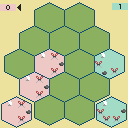Hey. This is a unique strategy game concept that I haven't seen before. It's fun, but only once you get it, otherwise it feels like one of those bootleg games that no matter what you do, you always lose (especially since a draw is also called "defeat"). Such games benefit especially from explanations with pictures and examples: two snowflakes next to each other, and text explaining which one will win. I'll be honest – in my early dev days it also baffled me how bad other people can be at understanding your tutorials, and confusion is never fun.
From a game design perspective: I think you could rework the way the snowflakes look, maybe make them black/white instead of circle/cross, just because it's hard to count the number of pixels in a corner especially when they're in the grid and you have a 1-pixel-wide line separating them, it just muddles the whole thing. You could also experiment with maybe having the snowflakes "attack" each other along the sides instead of the corners, or using a hexagonal grid. I feel that could really increase the potential for strategies. Or even just have a bigger grid. At the moment, it feels very dependent on luck of what pieces your opponent has, and it's deterministic in the same way that Tic Tac Toe is – if both players are sufficiently good, it will always lead to a draw. It only starts to get interesting when you have a bigger grid and have to put 5 in a row, for example.
One more thing – I think you meant to randomize the map at start but it randomizes after every level won, so you don't make any progress. And most gamepads don't have an "O" button – did you use an Ouya? Cause then you'd have O and U, not X.



